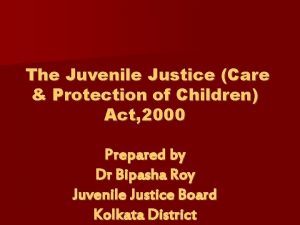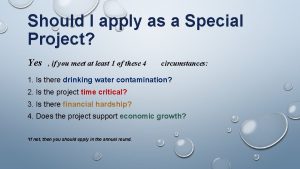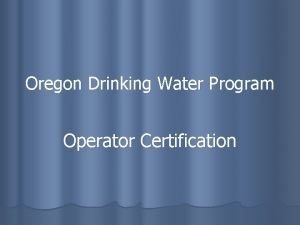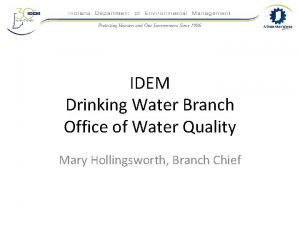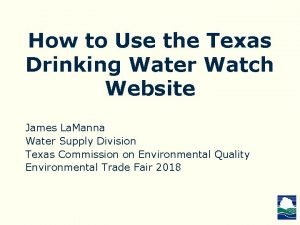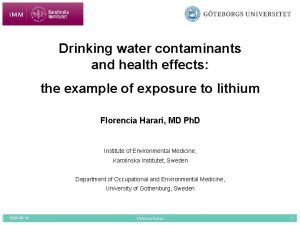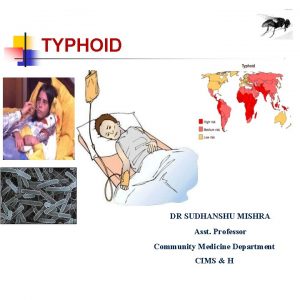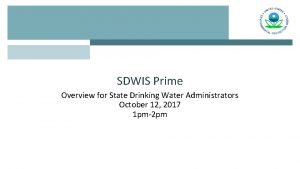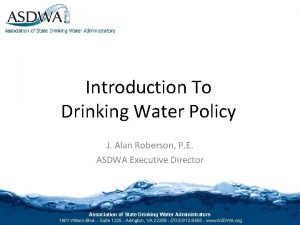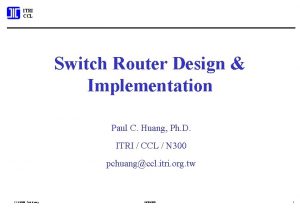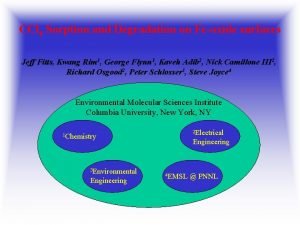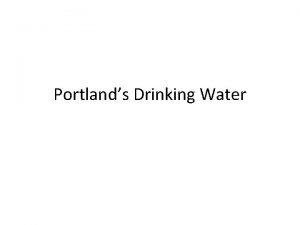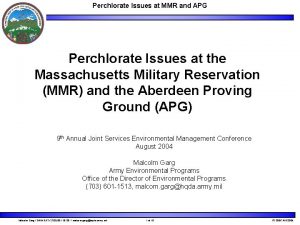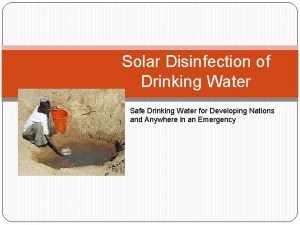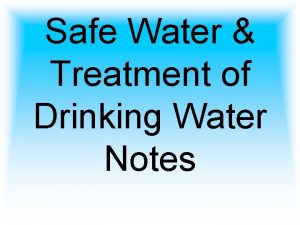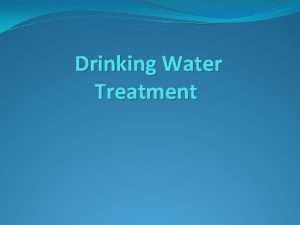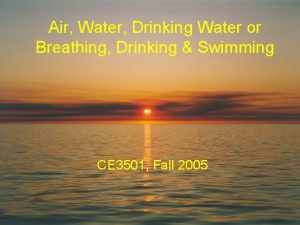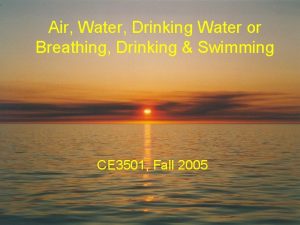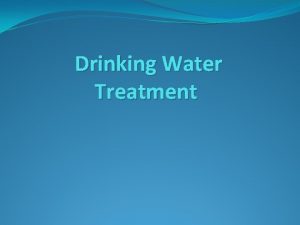Safe Drinking Water Act CCL and Perchlorate Technical

















- Slides: 17

Safe Drinking Water Act , CCL and Perchlorate Technical Support Project Meeting June 4, 2002 David Huber U. S. Environmental Protection Agency Office of Ground Water and Drinking Water

Contaminant Identification and Selection Under the SDWA z 1974 Safe Drinking Water Act (SDWA) çBut few contaminants regulated z 1986 Amendments to the SDWA çEPA to regulate 83 contaminants by 1989; çRegulate 25 contaminants every 3 years. z Congress, EPA, Stakeholders had concerns regarding the 1986 law: çStatutory deadlines; water systems encountered difficulty in timely compliance, financial capacity; çRequirement to regulate 25 contaminants every 3 years without regard for real health risk reduction 2

Contaminant Identification and Selection Under the SDWA z 1996 Amendments to the SDWA 1. Required EPA to publish a list of contaminants “known or anticipated to occur in public drinking water systems and which may require regulation” : Contaminant Candidate List (CCL) 2. Within 18 months of SDWA (2/98) and every 5 years 3. Broad consultation with stakeholders, National Drinking Water Advisory Council 3

Process of CCL Development: Listing Best Candidates z From various data bases, EPA pared down list of likely candidate contaminants to 260 z Further evaluated risk to public health, by exposure and health effect and quality of data z Selected best candidates: 60 4

CCL Chemical Screening Criteria 260 Chemical Contaminants Present in water at levels of public health concern No Yes Presence likely: Ambient Conc. Production Persistence Mobility No Yes High Relative Health Risk Include on CCL Low 50 Chemical 10 microbial Contaminants 5

Listing: Contaminant Candidate Selection under SDWA z Draft contaminant candidate list (CCL) Published on Oct. 6, 1997 çSolicited comment on approach, contaminants, data needs categories, inclusion of perchlorate çPublic comment indicated overall support for list, inclusion of perchlorate to the final CCL çProposed changes reviewed by NDWAC and its work group on contaminant selection z Final CCL published on March 2, 1998 1. Contains 50 chemicals and 10 microbiologicals 6

Contaminant Candidate List (CCL) z Functions of the CCL: çSource for determinations to regulate or not for at least 5 contaminants within 3 1/2 years after listing (originally due August 2001) çIs not the list of chemicals to regulate, but a starting point. çFocus and prioritize research agenda for contaminants with data gaps. Dismiss or issue guidance for contaminants which do not require regulation çBe the source for selection of contaminants for unregulated contaminant monitoring regulation (UCMR) finalized in 1999 7

Post Listing: Regulation Determination z Determination to Regulate contaminant based on S 1412(b)(1) çMay have adverse health effect çSubstantial likelihood of occurrence at frequency and level of public health concern çRegulation represents a meaningful opportunity for health risk reduction in public water systems 8

CCL and Next Steps CCL--60 contaminants Regulatory Determination Priorities--9 CCL contaminants Research & Occurrence Priorities: 54 including Cl. O 4 Actions 2002 Reg Determination Decision -- Regulate Further Analysis -- Don’t Regulate -- Other (guidance) Research: Treatment, Health, Analytical Methods Join Next CCL Occurrence Data Collection 2003 9

SDWA Criteria for Determination to Regulate May the contaminant adversely affect health of persons? Is the contaminant known or likely to occur in PWSs with a frequency and at levels posing a concern for public health? Regulate; publish MCLG and MCL Will regulation present a meaningful opportunity for health risk reduction? 10

Where do we get the data? Occurrence UCMR--2, 800 large 800 small CA/other state monitoring AWWSC Study 400 wells 16 states Superfund Sites DOD study AWWARF targeted; non- targeted Health Effects Analytical Methods Treatment Technologies NCEA Risk Characterization CA DHS Superfund Pilot and Full Scale Analytical Industry Air Force Other Human, Animal, and Epidemiological IPSC Studies Collaborative Work Academic, Industry Research EPA/ E. Valley Water District/ AWWARF research 11

Office of Water Perspectives on Perchlorate z Receives individual attention w/o specific statutory requirements in SDWA. z Research and occurrence a priority for the OGWDW. z EPA is very engaged in the 24 member IPSC êInteragency Perchlorate Steering Committee. Ensures exchange of information to support decision making 12

Regulatory and Policy Agenda for Perchlorate z Research continues; Determination to Regulation/not regulate is not made for this cycle of the CCL z Perchlorate is included in the final Unregulated Contaminant Monitoring list and occurrence data are coming in from other sources as well z EPA may issue Health Advisory as a guidance in the interim, before occurrence, treatment, analytical method, cost are available and a determination to regulate can be made. 13

EPA Health Advisory Program z Not federally enforceable. z Technical guidance to assist State, Tribal, and local officials responsible for protection of public health. z Subject to change as new information becomes available. 14

EPA Health Advisory Program z SDWA General Authority: 1. “The Administrator may publish health advisories (HA), which are not regulations, or take other appropriate actions for contaminants not subject to any national primary drinking water regulation. ” z Health Advisories 1. Represent an estimate of acceptable drinking water levels for chemical substances based on health effects information. It is not an enforceable standard but a technical guidance to Federal State and local officials. 15

EPA Health Advisory Program z One-day HA: çThe concentration of a chemical in drinking water that is not expected to cause any adverse noncarcinogenic effects for up to one day of exposure z Ten-day HA: çThe concentration of a chemical in drinking water that is not expected to cause any adverse noncarcinogenic effects for up to ten days of exposure z Lifetime HA: çThe concentration of a chemical in drinking water that is not expected to cause any adverse noncarcinogenic effects for a lifetime of exposure 16

Next Steps 1. Near Term: 1. Peer review report will be issued by this Fall 2. IRIS (Integrated Risk Information System) will meet to develop Rf. D by winter/spring 3. Possibly develop a Health Advisory 2. Longer Term (1 to 2 years): 1. As data gaps filled, perchlorate moves to the regulatory determination priority category. EPA may make “off-cycle” regulatory determination when data become available -- rather than wait until next CCL regulatory determination in 2006 17
 Water and water and water water
Water and water and water water Cncp and ccl
Cncp and ccl Safe feed safe food
Safe feed safe food Safe people safe places
Safe people safe places Tx dww
Tx dww Drinking water state revolving fund
Drinking water state revolving fund Oregon water treatment certification
Oregon water treatment certification Idem drinking water watch
Idem drinking water watch Texas drinking water watch website
Texas drinking water watch website Lithium in drinking water map
Lithium in drinking water map Typhoid medicine course
Typhoid medicine course Drinking water system operator certificate
Drinking water system operator certificate Prime drinking water
Prime drinking water Nm drinking water watch
Nm drinking water watch Ccl lambesc
Ccl lambesc Ccl lambesc
Ccl lambesc Ccl
Ccl Crystalline solid
Crystalline solid

